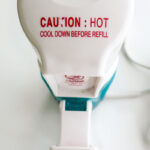Travel Trailer Vent Fans are essential for maintaining comfortable and healthy air circulation inside your RV. Looking for the best travel trailer vent fan options? SIXT.VN understands the importance of a well-ventilated space, especially when exploring the beauty of Vietnam. Let’s explore the world of RV ventilation, offering tips and recommendations to make your travel experience even better.
1. What Is a Travel Trailer Vent Fan and Why Do You Need One?
A travel trailer vent fan is a fan designed to be installed in the roof vent of a recreational vehicle (RV) or travel trailer. It helps to circulate air, remove stale odors, and reduce moisture, making the living space more comfortable.
You need a travel trailer vent fan for several reasons:
- Improved Air Circulation: Vent fans draw fresh air in and exhaust stale air, improving overall air quality.
- Moisture Reduction: They help to remove excess moisture, preventing mold and mildew growth, which is particularly important in humid climates like Vietnam. According to the Vietnam National Administration of Tourism, humidity levels can be quite high, especially during the monsoon season.
- Temperature Control: Vent fans can help cool down the interior of the RV by drawing out hot air, making the air conditioner more efficient.
- Odor Control: They effectively remove cooking odors, pet smells, and other unpleasant scents.
- Energy Efficiency: Using a vent fan can reduce the need for air conditioning, saving energy and extending battery life when boondocking.
2. What Are the Different Types of Travel Trailer Vent Fans Available?
There are several types of travel trailer vent fans, each with its own features and benefits:
2.1. Manual Vent Fans
Manual vent fans are the simplest type, requiring you to manually open and close the vent cover and turn the fan on and off.
- Pros:
- Affordable
- Simple to operate
- No electrical requirements (for non-powered models)
- Cons:
- Require manual operation
- Limited features
2.2. Electric Vent Fans
Electric vent fans are powered by the RV’s 12V electrical system and offer more features and convenience.
- Pros:
- Easy to operate with switches or remote controls
- Variable speed settings
- Some models include thermostats and rain sensors
- Cons:
- More expensive than manual fans
- Require electrical power
2.3. Two-Way Vent Fans
Two-way vent fans can blow air in or out, providing greater flexibility in air circulation.
- Pros:
- Versatile air circulation
- Can be used to exhaust stale air or bring in fresh air
- Cons:
- May consume more power
- Can be noisier than one-way fans
2.4. High-Powered Vent Fans
High-powered vent fans, like those from Maxxair and Fan-Tastic Vent, offer superior airflow and are ideal for larger RVs or those traveling in hot climates.
- Pros:
- Powerful airflow
- Effective at cooling and ventilation
- Some models have advanced features like automatic speed control
- Cons:
- More expensive
- Can be noisy at high speeds
2.5. Vent Fans with Rain Sensors
Vent fans with rain sensors automatically close the vent cover when they detect rain, preventing water damage to the RV interior.
- Pros:
- Protection from rain
- Convenient and worry-free operation
- Cons:
- May be more expensive
- Sensor can sometimes be overly sensitive
2.6. Vent Fans with Thermostats
Vent fans with thermostats automatically adjust the fan speed based on the interior temperature, maintaining a comfortable environment.
- Pros:
- Automatic temperature control
- Energy-efficient operation
- Cons:
- May be more expensive
- Thermostat accuracy can vary
3. What Factors Should You Consider When Choosing a Travel Trailer Vent Fan?
Choosing the right travel trailer vent fan involves considering several factors to ensure it meets your needs and preferences:
3.1. Size and Compatibility
Ensure the vent fan is the correct size for your RV’s roof vent opening. Most RVs use standard 14 x 14-inch vents, but it’s always best to measure.
3.2. Airflow (CFM)
Airflow is measured in cubic feet per minute (CFM). Higher CFM ratings indicate more powerful airflow. Choose a fan with sufficient CFM for the size of your RV.
3.3. Noise Level
Consider the noise level of the fan, especially if you plan to use it while sleeping. Look for fans with multiple speed settings to reduce noise when needed.
3.4. Power Consumption
Check the fan’s power consumption, especially if you frequently boondock. Opt for energy-efficient models to conserve battery power.
3.5. Features
Decide which features are important to you, such as a rain sensor, thermostat, remote control, or multiple speed settings.
3.6. Installation
Consider the ease of installation. Some vent fans are easy to install yourself, while others may require professional installation.
3.7. Price
Set a budget and compare prices of different models. Remember that higher-priced fans often offer more features and better performance.
4. How to Install a Travel Trailer Vent Fan?
Installing a travel trailer vent fan is a straightforward process, but it requires some basic tools and electrical knowledge. Here’s a step-by-step guide:
4.1. Gather Your Tools and Materials
- New vent fan
- Screwdriver
- Pliers
- Wire stripper
- Wire connectors
- Sealant (such as Dicor Lap Sealant)
- Ladder
- Safety glasses
- Gloves
4.2. Remove the Old Vent Fan
- Disconnect the RV from shore power and turn off the battery.
- Remove the interior trim ring and any hardware securing the old fan.
- Carefully disconnect the wiring, noting the polarity (positive and negative).
- Go onto the roof and remove any screws or sealant holding the old vent fan in place.
- Gently lift the old vent fan off the roof.
4.3. Clean the Mounting Surface
- Scrape away any old sealant and clean the mounting surface with a scraper and a solvent.
- Ensure the surface is clean, dry, and free of debris.
4.4. Apply New Sealant
- Apply a generous bead of sealant around the edge of the vent opening.
- Make sure the sealant creates a watertight seal to prevent leaks.
4.5. Install the New Vent Fan
- Carefully place the new vent fan into the opening, aligning it properly.
- Press down firmly to ensure the sealant makes good contact with the roof.
- Secure the vent fan with screws, following the manufacturer’s instructions.
4.6. Wire the New Vent Fan
- Connect the wiring, matching the polarity (positive to positive, negative to negative).
- Use wire connectors to ensure a secure and insulated connection.
- Tuck the wires neatly into the fan housing.
4.7. Install the Interior Trim Ring
- Install the interior trim ring and any remaining hardware.
- Ensure all screws are tightened properly.
4.8. Test the New Vent Fan
- Reconnect the RV to shore power and turn on the battery.
- Test the new vent fan to ensure it is working properly.
- Check for any leaks around the vent fan during the next rain.
Note: If you are not comfortable with electrical work or working on the roof of your RV, it is best to hire a professional to install the vent fan.
5. What Are Some of the Top Travel Trailer Vent Fan Brands?
Several brands offer high-quality travel trailer vent fans. Here are some of the top brands:
5.1. Maxxair
Maxxair is known for its high-performance vent fans with features like rain shields and remote controls. Their fans are durable and designed for long-lasting use.
5.2. Fan-Tastic Vent
Fan-Tastic Vent offers a range of vent fans with features like automatic speed control and reversible airflow. They are popular for their energy efficiency and quiet operation.
5.3. Dometic
Dometic is a well-known brand in the RV industry, offering a variety of vent fans with different features and price points.
5.4. Heng’s
Heng’s offers affordable and reliable vent fans that are easy to install and operate.
5.5. Camco
Camco provides a range of RV accessories, including vent fans. Their fans are budget-friendly and suitable for basic ventilation needs.
6. How to Maintain Your Travel Trailer Vent Fan?
Proper maintenance is essential to keep your travel trailer vent fan working efficiently and prolong its lifespan. Here are some maintenance tips:
6.1. Regular Cleaning
Clean the fan blades and vent cover regularly to remove dust, dirt, and debris. Use a soft brush or cloth and a mild cleaning solution.
6.2. Check the Sealant
Inspect the sealant around the vent fan regularly and reapply as needed to prevent leaks. Use a high-quality sealant like Dicor Lap Sealant.
6.3. Lubricate Moving Parts
Lubricate the fan motor and other moving parts periodically to ensure smooth operation. Use a silicone-based lubricant.
6.4. Inspect Wiring
Check the wiring regularly for any signs of damage or corrosion. Replace any damaged wires or connectors.
6.5. Replace the Vent Cover
Replace the vent cover if it becomes cracked or damaged. A damaged vent cover can allow water to enter the RV.
7. What Are Some Tips for Using Your Travel Trailer Vent Fan Effectively?
Using your travel trailer vent fan effectively can help maximize its benefits and improve your comfort. Here are some tips:
7.1. Use the Fan to Exhaust Hot Air
During the hottest part of the day, use the vent fan to exhaust hot air from the RV. This can help reduce the need for air conditioning.
7.2. Use the Fan to Bring in Fresh Air
In the morning and evening, use the vent fan to bring in fresh air and circulate it throughout the RV.
7.3. Use Multiple Fans
If you have multiple vent fans, use them in combination to create a cross breeze and improve air circulation.
7.4. Use the Fan with Windows Open
Open windows and other vents to allow for better airflow and ventilation.
7.5. Monitor Humidity Levels
Monitor the humidity levels inside the RV and use the vent fan to remove excess moisture. This can help prevent mold and mildew growth. According to a study by the Vietnam Institute for Building Science and Technology, maintaining proper ventilation can significantly reduce indoor humidity.
8. What Are Some Common Problems with Travel Trailer Vent Fans and How to Fix Them?
Even with proper maintenance, travel trailer vent fans can sometimes experience problems. Here are some common issues and how to fix them:
8.1. Fan Not Working
- Cause: Blown fuse, disconnected wiring, or faulty motor.
- Solution: Check the fuse and replace it if necessary. Inspect the wiring and reconnect any loose connections. If the motor is faulty, replace the fan.
8.2. Fan Running Slowly
- Cause: Low voltage, dirty fan blades, or worn motor.
- Solution: Ensure the RV battery is fully charged. Clean the fan blades and lubricate the motor. If the motor is worn, replace the fan.
8.3. Leaks Around the Vent Fan
- Cause: Cracked sealant or damaged vent cover.
- Solution: Remove the old sealant and apply new sealant. Replace the vent cover if it is damaged.
8.4. Noisy Fan
- Cause: Loose screws, unbalanced fan blades, or worn motor.
- Solution: Tighten any loose screws. Balance the fan blades by cleaning them and ensuring they are not bent. If the motor is worn, replace the fan.
8.5. Rain Sensor Not Working
- Cause: Dirty sensor or faulty sensor.
- Solution: Clean the sensor with a soft cloth. If the sensor is faulty, replace it.
9. How Can SIXT.VN Help You With Your Travel Trailer Needs in Vietnam?
SIXT.VN is your go-to partner for convenient and reliable travel services in Vietnam. Whether you’re planning a cross-country RV adventure or a local getaway, we offer a range of services to make your trip seamless:
- Airport Transfers: Start your journey stress-free with our reliable airport transfer services. We’ll pick you up and drop you off on time, every time.
- Hotel Bookings: Find the perfect accommodation with our extensive selection of hotels. From budget-friendly options to luxury resorts, we have something for everyone.
- Tours: Explore the best of Vietnam with our expertly curated tours. Discover hidden gems and iconic landmarks with our knowledgeable guides.
- Flight Bookings: Get the best deals on flights to and from Vietnam. Our easy-to-use booking platform makes it simple to find the perfect flight for your travel plans.
10. Frequently Asked Questions (FAQs) About Travel Trailer Vent Fans
10.1. What size vent fan do I need for my RV?
Most RVs use standard 14 x 14-inch vent openings. Measure your vent opening to ensure you purchase the correct size.
10.2. How much power does a travel trailer vent fan use?
Power consumption varies depending on the fan model and speed setting. Check the manufacturer’s specifications for power consumption details.
10.3. Can I leave my vent fan on while it’s raining?
If your vent fan has a rain sensor, it will automatically close the vent cover when it detects rain. Otherwise, it’s best to close the vent fan manually to prevent water damage.
10.4. How often should I clean my vent fan?
Clean your vent fan at least once a month, or more often if you travel in dusty or humid conditions.
10.5. Can I install a vent fan myself?
If you are comfortable with electrical work and working on the roof of your RV, you can install a vent fan yourself. Otherwise, it’s best to hire a professional.
10.6. What is CFM in relation to vent fans?
CFM stands for cubic feet per minute, which measures the amount of air a fan can move. Higher CFM ratings indicate more powerful airflow.
10.7. Are vent fans noisy?
Some vent fans can be noisy, especially at high speeds. Look for fans with multiple speed settings to reduce noise when needed.
10.8. How do I choose the right vent fan for my needs?
Consider the size of your RV, your budget, and the features that are important to you, such as a rain sensor, thermostat, or remote control.
10.9. Where can I buy a travel trailer vent fan?
You can buy travel trailer vent fans at RV dealerships, camping supply stores, and online retailers like Amazon and Camping World.
10.10. How do I know if my vent fan is working properly?
Check the fan for proper airflow and listen for any unusual noises. Ensure the vent cover opens and closes smoothly.
Choosing the right travel trailer vent fan can greatly enhance your RV experience, providing improved air circulation, moisture control, and overall comfort. SIXT.VN is here to support your travel needs in Vietnam, offering reliable and convenient services to make your trip unforgettable.
Ready to explore Vietnam with ease? Visit SIXT.VN today to book your airport transfer, hotel, tour, or flight! Let us take care of the details so you can focus on enjoying your adventure.
Address: 260 Cau Giay, Hanoi, Vietnam
Hotline/Whatsapp: +84 986 244 358
Website: SIXT.VN






